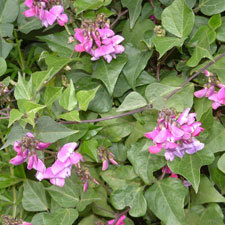 Mile-a-minute
Mile-a-minute
Common name: Mile-a-minute; Sweet pea vine; pea vine
Botanical name: Dipogon lignosus
Management category: Sustained control - Rule 5a applies
Originally from South Africa it is one of the world’s worst weeds, aptly named because it can rapidly choke and smother other plants.
Why is it a pest?
- Rapidly smothers low growing shrubs and regenerating native forest canopy, and eventually takes over completely shading out the plants underneath.
- Seeds drop near parent plants, but mostly is spread in dumped vegetation or soil and also by sea or fresh water.
- Increases nitrogen which can alter the species that can grow at sites it invades.
- Tolerates drought or damp conditions, wind, salt, poor soils and damage.
Where is it found?
- Thrives in bare sites and invades forest margins, coastal areas, cliffs, shrub lands and limestone areas.
- Gardens, roadsides, vacant land and hedges are all common locations where it is found.
What does it look like?
- An evergreen, climbing vine with rounded, moderately hairy stems that are woody towards their base.
- Pea-like white, lavender and white, or pink to reddish purple flowers are produced from spring to summer.
- Flowers develop into boat-shaped seed pods (35mm long) that ripen and split to release seeds.
What are the rules?
Sustained control
Sustained Control pests are well established in the region and preventing the spread is no longer a realistic objective. Management focuses on reducing general impacts of the pest. Landowners/occupiers are responsible for the control of these pest species on their land. Council may enforce control.
Under rule 5a of the RPMP landowners/occupiers must destroy this pest if required by a written direction from an authorised person unless a property specific pest management agreement has been agreed and signed between the occupier and the Council.
Criteria to meet Rule 5A include when the species is being actively managed by council, other agency and or community group, on an adjacent property. See the Regional Pest Management Plan 2020-2030 rules for Sustained control pests for more information.
How do you get rid of it?
- Hand-pull – dispose of material by incineration or refuse station.
- Cut and Paste (all year)
- Spraying (spring to autumn)
CAUTION: When using any herbicide or pesticide, PLEASE READ THE LABEL THOROUGHLY to ensure that all instructions and directions for the purchase, use and storage of the product, are followed and adhered to.
Read more on pest control advice, information and regulations.
Images







